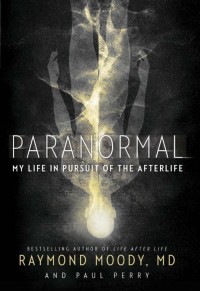Paranormal: My Life in Pursuit of the Afterlife

 By Raymond Moody, MD, and Paul Perry
By Raymond Moody, MD, and Paul Perry
HarperCollins Publishers, HarperOne, 2012 Click to Buy this Book!
Paranormal is the autobiography of Raymond A. Moody, Jr., MD (b. June 30, 1944 in the small town of Porterdale, Georgia). It is the thirteenth book he has published, with five co-authored by Paul Perry, author of Transformed by the Light. Dr. Moody is a psychiatrist who is best known for his first book Life After Life: The Investigation of a Phenomenon – Survival of Bodily Death. First published in 1975 when Moody was 31-years old, this book definitely spoke to the new consciousness of the time, for interest in such subjects as the paranormal, the occult, “out-of-body” experiences, and karma and reincarnation had increased enormously in the early 1970s. Life After Life “… Climbed onto every bestseller list in the world, where it stayed for more than three years. Why this took place can be answered in one word: vacuum. Up to this point the subject had been considered one that belonged to the world of religion, and therefore it had received little if any examination by medical science. Hence, there was no real scientific examination of the possibility of life after life.” However, this statement does not take into account the major contributions that had been made at the beginning of the 20th century through the lifework of Rudolf Steiner (1861-1925) and many others — including groups of physicians — within the streams of Anthroposophy or Spiritual Science. During the 1970s many of the books by Rudolf Steiner that had been translated into English appeared in public libraries and in book stores, including Knowledge of the Higher Worlds and Its Attainment, copyright 1947, that contained, e.g., chapters on “The Continuity of Consciousness” and “Life and Death,” and Occult Science – An Outline, copyright 1969, with subsections from Chapter VII titled “Man’s Life After Death,” and “The Way to Supersensible Cognition.”
The above citations are not intended in any way to diminish the value of the independent, groundbreaking work of Dr. Moody, who originated the term near-death experience (NDE), but only to point out that there had not been a “vacuum” in these areas, but a lack of academic and public knowledge about the accessibility of the literature of Anthroposophy and Spiritual Science and the new evolutionary impulses in the advances of consciousness that these movements facilitated. Part of the great value of Life After Life, with its personal accounts of NDEs, is that it became a popular and well-known book; profound experiences of a shift in consciousness to a real spiritual existence following severe crises of suffering were conveyed to readers in friendly everyday language; the deepest questions about death began to be answered, and hope was offered for possible further contact and communication with loved ones who had died.
Paranormal offers something of the psychoanalytic self-evaluation that might be expected of a psychiatrist, but it is largely an informal life review for purposes of revealing Dr. Moody’s painful struggle with the disease of hypothyroidism, called myxedema, and how this affected his life, yet more importantly – as some readers will wonder from the beginning – how this may have affected his work. The Introduction describes Dr. Moody’s suicide attempt in 1991 with an overdose of Darvon, a result of the fact that his long-misdiagnosed illness had reached an unbearable stage. “From my late twenties until now I have lived with a disease called myxedema. This is a difficult affliction to diagnose. Simply stated, with this disease the thyroid gland does not produce enough thyroxine, a hormone that acts in our body something like the volume dial on a radio. The result of this disease is a variety of peculiar symptoms that can lead to myxedema madness, in which the afflicted person gradually loses his mind.” His life was saved through a phone call made to Paul Perry, who apparently kept Dr. Moody on the phone long enough for the police and then the Emergency Medical Technicians to reach him. The generally short Chapters that follow the Introduction detail his life: the death of his beloved grandfather, his early interest in astronomy, his discovery of Plato’s The Republic while a student at the University of Virginia, More »